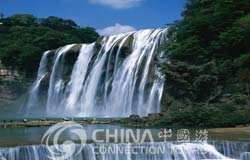Anshun lies in the middle and western part of Guizhou Province, in southwest China. It is located at the east of Yungui Plateau. Anshun city sits on the dividing line of the Yangtze, Wujiang Rivers and the Beipang River Valley of the Pearl River. It covers a total area of 9,264 sq km with a population of 2.5 million. The topography of the city is hilly. The climate has strong subtropical monsoon features with an annual average temperature of 15 C. With plenty of rainfall (average precipitation of 1300 mm) and frost (free period of 280 days), the weather is mild in Anshun, without hot summers or cold winters.
 The most famous tourist attractions are the Huangguoshu Waterfall, the highest waterfall in Asia, the Tianxing scenic spot, known as “the natural great potted landscape", the Dragon Palace Caves, where one can take a boat ride on an underground river, flowing into a cave. The waterfall pouring through an opening into a natural amphitheater is truly spectacular.
The most famous tourist attractions are the Huangguoshu Waterfall, the highest waterfall in Asia, the Tianxing scenic spot, known as “the natural great potted landscape", the Dragon Palace Caves, where one can take a boat ride on an underground river, flowing into a cave. The waterfall pouring through an opening into a natural amphitheater is truly spectacular.
Anshun is home to more than 15 of China's 56 ethnic minorities, such as the Miao, the Buyi, the Dong, the Yi, the Gelao, the Tujia, the Hui, the Zhuang, and the Yao. As many as 1000 ethnic festivals are held during the year.
Some of the main festivals are: The Singing Festival and the Wedding Celebration of the Dong people; the Dragon Boat Festival, the New Rice Tasting Festival and Sister's Meal Festival of the Miao; Scarifying the Holly Tree of the Gelao; the Festival of the Yao. During these times of celebration, people put on their most colorful clothing and gather for a big party. The minorities retain most of their unique customs. They hold elaborate welcoming ceremonies, worship their totems, and play intriguing music with graceful dances.

